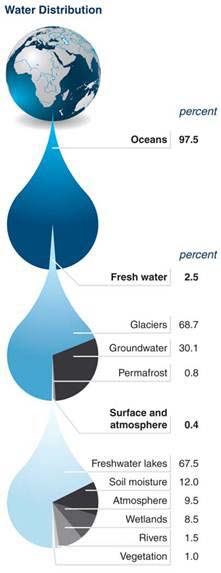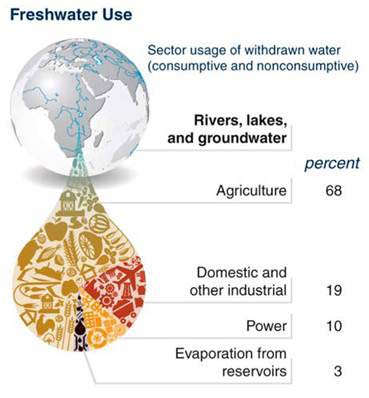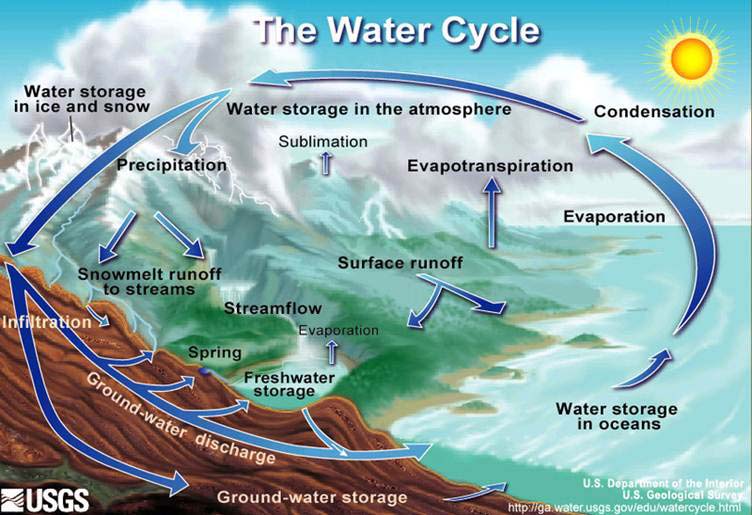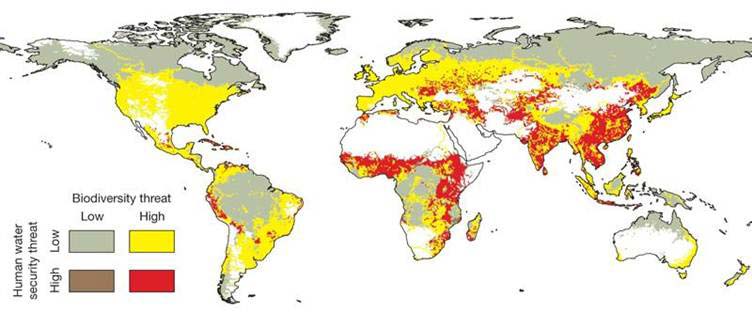The most essential of natural resources is being depleted and degraded at unsustainable rates and further threatened by human-induced global warming; but the looming crisis is avoidable Dr. Mae-Wan Ho
The ancient mariner’s curse is about to strike the world, unless we mend our wicked profligate ways. There is indeed abundant water on our planet, but less than 1 % of it is fresh and clean enough to live on (see Box 1).
Box 1
Abundant water exists on our planet, but 97.5 % is salt water in the oceans, while freshwater – on which all terrestrial life including the human species depends - makes up just 2.5 %, and only a small proportion of that is available for human beings and other terrestrial life. Some 68.7 % of freshwater is bound up in glaciers and 0.8 % in permafrost, leaving 30.1 % groundwater accessible through wells and pumping through boreholes and the remaining 0.4 % readily available surface and atmospheric water. Of the readily available water, freshwater lakes make up 67.5 %, soil moisture 12.0 %, water vapour in the atmosphere 9.5 %, wetlands 8.5 %, rivers 1.5 % and vegetation 1.0 % (Figure 1) [1].

Figure 1 Freshwater resources of Earth
Water is used by different sectors of human activity; by far the biggest user is agriculture (Figure 2).

Figure 2 Freshwater use by sector
Freshwater is a renewable resource; it cycles through land, oceans and the atmosphere (Figure 3) [2]. Unfortunately, it is being consumed faster than it can be renewed.

Figure 3 Earth’s water cycle
Groundwater is the largest reservoir of freshwater, and about 2 billion people depend on it for agriculture and their daily lives [1]. These underground reservoirs also sustain streams, wetlands, and ecosystems, and defend against land subsidence and salt water intrusion into fresh water supplies. Groundwater depletion has become a serious issue for many years, as it is used up faster than it can be recharged by precipitation.
A study published in 2010 found that the rate of depletion has more than doubled since 1960 [3]. So much water is being drawn from below that simply through runoffs, evaporation, and precipitation, enough is added to the oceans to account for about 25 % of the annual sea level rise across the planet.
Lead author of the study Marc Bierkens of Utrecht University, the Netherlands told ScienceDaily [4]: “If you let the population grow by extending the irrigated areas using groundwater that is not being recharged, then you will run into a wall at a certain point in time, and you will have hunger and social unrest to go with it.”
The study estimated the rates at which groundwater is withdrawn and recharged by means of a model driven by data from a global groundwater database. The model is a groundwater layer beneath two stacked soil layers, exposed at the top to rainfall, evaporation, and other effects; and the data consists of 44 years (1958-2001) of records on precipitation, temperature, and evaporation.
Applying the analysis worldwide to regions ranging from arid to those with the wetness of grasslands (short of humid), the team confirmed that underground water stocks are shrinking, and the rate has more than doubled between 1960 and 2000, from 126 to 283 m3 per year. Because the total amount of groundwater in the world is unknown, it is hard to tell how fast the global supply would vanish altogether. But if water were drawn as rapidly from the Great Lakes, they would go dry in 80 years.
It is clear that any reduction in the availability of groundwater supplies could have profound effects, especially for a growing human population.
The assessment showed the highest rates of depletion in some of the world’s most important agricultural regions, including northwest India, northeast China, northeast Pakistan, California’s central valley, and the midwestern United States.
“The rate of depletion increased almost linearly from the 1960s to the early 1990s,” said Bierkens. “But then you see a sharp increase which is related to the increase of upcoming economies and population numbers; mainly in India and China.”
As groundwater is increasingly withdrawn, the water table will eventually fall so low that an ordinary farmer cannot reach it anymore, said Bierkens. Some nations will be able to use expensive technologies to get fresh water for food production such as desalination, or artificial groundwater recharge, but many will not have the option.
Groundwater use adds about 0.8 millimetres per year to sea level rise, which is about a quarter of the total 3.1 millimetres per year, and as much as from the melting of glaciers and icecaps outside Greenland and Antarctica.
In the same year, a study published in the journal Nature documented the serious degradation of the world’s rivers [5, 6]. Rivers are the chief source of renewable water supply for humans and freshwater ecosystems in the rivers’ extensive basin of tributaries.
The study, led by Charles Vörösmarty, a civil engineer at the City University of New York, revealed that even rich countries have some of the most stressed and threatened areas for biodiversity. The team carried out a computer-based assessment to quantify the known threats to water security and freshwater biodiversity in the world’s river systems. They produced a series of maps showing the cumulative effect of the multiple threats. One map illustrated areas where human water security is affected, together with the severity of the threats. Another covers the same areas and threats for biodiversity, and a third map combined the two surveys (Figure 4).

Figure 4 Map of the state of Earth’s river basins in terms of threats to human water security and natural biodiversity
As can be seen, regions of the world with intensive agriculture and dense human settlement, such as south and southeast Asia, north and east Africa, and even parts of Europe experience some of the highest levels of threats to both water security and biodiversity. Furthermore, local impacts are transported downstream, with more than 30 of the 47 largest rivers in the world, including the Nile, recording at least moderate threat levels at the river mouth. Only a small fraction of the world's rivers are unaffected by humans, with remote parts of the Amazon that flow through dense rainforest showing the lowest levels of threats.
Previous research has already found that nearly all European river basins are heavily affected by human activities, especially water pollution. The European Water Framework Directive, which requires Member States to achieve good ecological status for surface and ground water by 2015, needs a consistent and comparable identification of significant anthropogenic pressures and the assessment of their impacts.
Researchers at the University of Natural Resources and Life Sciences in Vienna, Austria, carried out the first high-resolution data analysis of human pressures on rivers in Europe. A total of 9 330 samples from approximately 3 100 rivers in 14 European countries were analyzed [7, 8].
They identified 15 human-caused degradation of river water. These are scored individually and aggregated into 4 pressure groups (and an average score produced for each group): water quality (different kinds of pollutants), hydrology (water withdrawal and anything that reduces or increases flow volume or rate), morphology (change in the shape of the riven including artificial embankment and dykes), and connectivity (barriers on upstream catchment segment or downstream river segment).
The analysis found water quality affected in 59 % of rivers; hydrology in 41 % and morphology in 38 %. Connectivity is disrupted at the catchment level in 85 % and by 35 % at river level. Approximately 31 % of all sites are affected by one, 29 % by two, 28 % by three and 12 % by all four pressure groups; only 21 % are unaffected. Some 90 % of lowland rivers are impacted by a combination of all four pressure groups.
The worst affected regions were the Central highlands, mainly in Austria and Germany, the Hungarian lowlands, the Western highlands (in France and Switzerland) and the Western plains (predominantly France). Sites near the source of the river were generally less affected than lowland rivers where multiple impacts were more common.
The study predicted that human-induced pressures are likely to intensify. The increased number of extreme weather events will result in greater river flow variation, and there will be growing demand for water in agriculture and energy production.
A report prepared by Intelligence Community Assessment (ICA) for the US Department of State addressed the question: How will water problems impact US national security interests and transboundary issues over the next 30 years?
The unclassified version of the report released in February 2012 [1], revealed that it focused on a number of states “strategically important to the United States” in a selected set of river basins; these were assessed for water management capacity politically and environmentally, and rated ‘moderate’, ‘limited’, or downright ‘inadequate’ (see Table 1).
| River basin | Countries | Assessment |
| Indus | Pakistan and India | Moderate |
| Jordan | Jordan, West Bank, Israel, Syria, Lebanon | Moderate |
| Mekong | Vietnam, Cambodia, Thailand, Laos, Myanmar, Yemen, Tibet, Qinghai (China) | Limited |
| Nile | Egypt, Eritrea, Sudan, Ethiopia, Central African Republic, Dem. Rep. Congo, Kenya, Burundi, Tanzania | Limited |
| Tigris-Euphrates | Iran, Iraq, Saudi Arabia, Syria | Limited |
| Amu Darya | Uzbekistan, Turkmenistan, Tajikistan, Afganistan, Kyrgyzstan | Inadequate |
| Brahmaputra | Bangladesh, India, Nepal, Bhutan | Inadequate |
The report concludes that between now and 2040, fresh water availability will not keep up with demand unless more effective management of water resources is put into place. Water problems – shortages, pollution, or floods – will hinder the ability of key countries to produce food and generate energy, posing a risk to global food production and hampering economic growth. As a result of demographic and economic development pressures, North Africa, the Middle East, and South Asia will face major challenges from water problems.
Although water problems by themselves are unlikely to result in state failure, this may happen through social unrest when combined with poverty, social tensions, environmental degradation, ineffectual leadership and weak political institutions.
During the next ten years, the depletion of groundwater in some agricultural areas will pose a risk to both national and global food markets.
From now through to 2040, improved water management will give the best solutions; as for example, by pricing allocations and virtual water trade, and investments in water-related sectors such as agriculture, power, and water treatments.
As agriculture uses approximately 70 % of the global fresh water supply, the greatest potential for relief from water scarcity will be through technology that reduces water required for agriculture.
The ICA report [1] predicts that within the next 30 years, global demand for fresh water will increase and outpace supply unless effective water management is put into place. Annual global water requirements will reach 6 900 billion m3 in 2030, 40 % above current levels. According to the 2007 United Nations Intergovernmental Panel on Climate Change (IPCC), there will be water shortages in many areas of the world, especially semi-arid and arid areas such as the Mediterranean, western United States, southern Africa, northeast Brazil, southern and eastern Australia.
Agriculture accounts for ~3 100 billion m3, or just under 70 % of global water use today, and if current practices and efficiencies continue, this will rise to 4 500 billion m3 or 65 % of all water withdrawals by 2030. The pressure from food production for a large increase in population is exacerbated by growing crops for biofuels (Box 2).
Box 2
The biomass required to produce one litre of biofuel consumes between 1 000 and 3 500 litres of water. The World Bank projects that by 203o, land allocated to biofuels will increase fourfold, mostly in North America to 10 % and Europe to 15 % of arable land. In the developing world, bioenergy crops will reach 0.4 % of arable land in Africa, 3 % in Asia and 3 % in Latin America.
The world’s population is projected to grow by 1.2 billion between 2009 and 2025 from 6.8 billion to 8 million. Urbanization in the developing world, industrial growth, sanitation requirement, and increase in meat consumption, will all drive up water consumption.
But the water supply is dwindling. By 2030, one-third of the world’s population will live near water basins where the water deficit will be larger than 50 %. A number of countries are already experiencing high water stress, when the annual renewable freshwater supplies are below 1 700 m3 per person. These include the western United States, northern Africa, southern Africa, the Middle East, Australia and parts of south Asia and China. (Water scarcity is when annual water supply is less than 1 000 m3 per person per year; in comparison, the US currently uses 2 500 m3 per person per year.)
Poor water management will further reduce water supplies by inefficient water consumption, deforestation and soil degradation, poor infrastructures in cities with leakage rates between 30-50 %, and evaporation from reservoirs.
The IPCC reports that the risk of both drought and floods will increase markedly in many parts of the world by the end of the century due to increase in extreme weather. During the next few decades rising sea levels and deteriorating coastal buffers will amplify severe storm damage. Drinking water from both aquifers and surface water resources almost certainly will further decline as water quality decreases from salt-water intrusion due to groundwater depletion and sea level rise (see above).
The ICA Report [1] goes into the impacts of water insecurity in some detail.
Political instability
Historically, water tensions have led to more water-sharing
agreement between states than violent conflicts. However, as water shortages
become more acute beyond the next ten years, water in shared basins will
increasingly be used as leverage. There will be increasing use of water or
water infrastructure as a weapon - both between states and within states to
suppress separatists - or as targets of terrorist attacks.
Food & energy insecurity
If water problems are not managed adequately, food
production will suffer, as well as energy production in hydroelectric power.
These problems, exacerbated by poverty and social inequality, environmental
degradation, and weak political institutions, may well result in social unrest
and state failure.
Agriculture & economic growth
As mentioned earlier, numerous countries have already
over-pumped their groundwater, which may reach levels insufficient for
agriculture. Reduction in agriculture stymies economic growth. Currently 35 %
of the global labour force is employed in agriculture, but is a lot higher in developing
countries, where agriculture could account for 95 % of water use.
The US NASA (National Aeronautics and Space Administration) satellite data show that water is being depleted faster in northern India than in any other comparable region in the world. A World Bank 2005 study found that groundwater irrigation directly or indirectly supported 60 % of India’s food production and 15 % of India’s food production depended on unsustainable groundwater use.
Energy & economic output
Economic output will drop if there is insufficient clean
water to generate electricity to maintain and expand manufacturing industry and
extraction of resources (including mining). Hydropower is important in the
developing world. More than 15 developing countries generate 80 % or more of
their electricity from hydropower. Demand for water in energy generation and
industrial processing is increasing.
Increased risk of disease
Water scarcity - due in part to poor water infrastructure
and lack of sanitation - forces people to drink unsafe water, increasing the
risk of waterborne diseases such as cholera, dysentery, and typhoid fever.
Water diversion projects such as dams and reservoirs and irrigation systems
create stagnant or slow-moving water that allow mosquitoes, snails, copepods
and other disease-transmitting vectors to breed.
On average, a child dies from a water-related disease every 15 seconds, according the 2006 United Nations Human Development Report. Unsafe drinking water and poor sanitation are leading causes of death in the developing world for children under age 5. Nearly half of all people in developing nations suffer from a health problem related to water and sanitation. The cholera outbreak in Haiti that made 455 000 ill and claimed the lives of 6 400 (as of 20 September 2011) was initiated by contamination of the Artibonite River during low flow levels. During the raining and hurricane season of 2010, cholera spread nationwide, further contaminating drinking water supplies. Trachoma, which threatens 400 million with blindness and is prevalent in children, is a direct result of dry, dusty, water-scarce environments lacking in sanitation, according to the World Health Organisation (WHO).
The UN Millennium Development Goals (MDGs) – a global action plan to achieve anti-poverty goals by 2015 – includes universal access to water and sanitation. The World Bank estimates that even if countries develop policies and improve water institutions, the additional external foreign aid needed to achieve the Water and Sanitation MDG by 2015 is between USD $5-21 billion. The WHO, however, estimates that $190 billion investment is needed each year until 2015 to achieve and maintain the water and sanitation targets in all regions [9]. This compares with $7.8 billion global aid in 2010.
The ICA Report concludes that the best way to avert a potential global water crisis from now through 2040 is by improving water management through pricing, allocation, and trade in products with high virtual water content. (Virtual water is freshwater used or consumed in the development or production of a good or commodity. The global average virtual water content of maize, wheat and rice (husked) is 900, 1 300 and 3 000 m3/ton respectively, whereas that of chicken meat, pork and beef are 3 900, 4 900 and 15 500 m3/ton respectively.) At the same time, there should be investments in water-related sectors such as agriculture, power, and water treatment. Because agriculture uses by far the largest proportion of global freshwater, the greatest potential to avert water scarcity is through technology that reduces water needed in agriculture. We should also stop growing thirsty crops such as citrus fruit in dry areas.
The European Union is taking water efficiency very seriously, and has recommended numerous measures including the use of wastewater from treatment plants and grey water in agriculture (see [10] Using Water Sustainably, SiS 56).
One should mention here more radical changes in cultivation that have not received sufficient attention in the context of sustainable water use.
A rice cultivating technique - system of rice intensification (SRI) (see [11, 12] Fantastic Rice Yields Fact or Fallacy?, Does SRI work? SiS 23) – has been shown to double and triple yield at a small fraction of the conventional water use. The technique is already widely adopted around the world, along with organic agro-ecological practices that prevent water pollution and improve percolation of water and the water storage-capacity of soils particularly during years of drought. In addition, organic agriculture saves on energy and carbon emissions, organic soils sequester carbon and organic produce brings numerous health and economic benefits (see our comprehensive report [13] Food futures now, organic, sustainable fossil fuel free, I-SIS/TWN publication).
Another important approach is sustainable saline agriculture ([14] Saline Agriculture to Feed and Fuel the World, SiS 42), using sea-water to cultivate naturally salt-tolerant plants for food and fuel, which effectively recycles nutrients back from sea to shore.
Article first published 26/09/12
Comments are now closed for this article
There are 4 comments on this article.
Rory Short Comment left 28th September 2012 03:03:25
I have just finished reading Wes Jackson's book 'Consulting the Genius of the Place'. In it he shows that our abuse of the eco-sphere started with the agricultural revolution some 10,000 years ago when humankind first domesticated annual grasses for grains rather than perennial grasses. Even though it has undoubtedly been obvious to untold generations that agriculture using annual grains is environmentally destructive we have been quite unable to conceive of doing anything else and have not questioned the annuality of grains rather we have been trying to ameliorate the negative consequences of their cultivation through equally ecologically destructive behaviours like using chemical fertilisers. With regard to water usage I would guess that the cultivation of perennial grains would be much less demanding of water than the equivalent annual grains. That is where they exist of course and Wes Jackson through 'The Land Institute', which he established in Kansas USA, has been working to develop perennial grain crops for the last 30 years. In my view his efforts are creating a glimmer of light at the end of a very dark tunnel.
Varghese John Comment left 5th October 2012 19:07:33
I guess we cannot call water usage for agriculture as mis-usage.Recycling and various well known methods of conservation,prevention of pollution and improving catchment efficiencies can go far.Many of us now are awere of the problems but Action on our part individually and collectively is lagging far behind.More and continously education through all available media should be vigourously followed.Incentivisation and other reward methods can be set up.I wish Wes Jackson and his programme all sucess.
Todd Millions Comment left 7th October 2012 15:03:27
I'm sadly lacking in specific references,but this summer-'western Producer' reported that the plant breeder who developed 'rice of the prairies'hulless oats has being honoured with a statue in China for this crop-turns out he accidently developed a salt tolerant strain,by using a breeding greenhouse drawing on salined water.Thus a crop I can't get in Canada,is turning large areas of high salt soil in China too a highly nutricious crop that fits with local cusine.Hopefully mass posioning bioweenies won't get ahold of it.Serindipity ineed.
Harold Titsonbeli,sr Comment left 18th October 2012 07:07:08
Well done.The issue that holds the greatest promise is seldom seldom mentioned,and needs proper support.The honesty to address over population .I have tried to have children,still trying,and I believe my effects have contributed to the solution,so I can say keep trying ,just don't re produce,and the problems shrink ......Harry